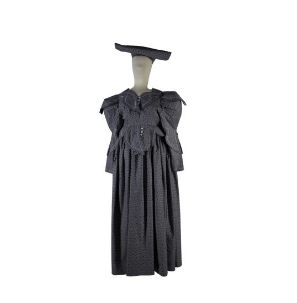Holy Cow!
This whole object exemplifies the importance of cows for the Himba, as both the exterior and the interior are based on the cow.
Cows are a fundamental part of Himba people’s lives, as they centre their daily lives and culture on cattle. The women depend on them for their body make-up, clothing and accessories. Cattle are further a sign of influence, wealth and power within societies; the more cows a man owns, the stronger his claim to leadership is.[Wärnlöf 2000, p 179] Cows play a powerful and sacred role in all major events in the life of a Himba, such as childbirth, marriage, and funeral.[Sterling Cameron 2012, p 21]
The role of the cow can be traced to another tribe in Namibia – the Herero. In a previous story I chose to tell the story of their eye-catching, colorful dresses. As for the Herero, the centrality of the cow becomes obvious when looking at their dress and especially their headdress representing the horns of cattle (more information can be found in the other story).
Today, the Himba and the Herero are two distinct tribes, but not too long ago, they both belonged to the same tribe. When returning to Namibia after having fled from the Germans during the brutal genocide (1904-1908), the small number of surviving Herero moved further south while the Himba subgroup settled in the northwest of the country - that is how the two tribes split up.[Borg and Jacobsohan 2013, p 45]
The Herero then got into closer contact with the Germans and the British and adopted their dress, Christianity, and a sedentary lifestyle.[Wärnlöf 2000, p 182] In the meantime, the Himba stayed rather remote from external influences and continued to lead their semi-nomadic lifestyle.[Borg and Jacobsohan, Ibid] Both groups seem to lead very different lives today, but they do still have close ties enforced through intermarriage and grazing assistance.[Wärnlöf, Ibid]
We can therefore see that in most aspects, the Himba managed to maintain the lifestyle original to the Herero from the time before the German occupation of the country. According to Jim Naughten, photographer of the photo series I used for the Herero dress story, “most tourists travel to the north to photograph the Himba.” They seem to embody the image of what outsiders imagine ‘traditional African people’ to look like. Consequently, the Himba have made showing this ‘traditional’ and ‘ethnic’ life to tourists their main source of income.[Wärnlöf, Ibid, p 188] Representation plays a big role here, and thus it seems like in most cases, the daily realities and adapted lifestyles of the Himba seem to be ignored; two examples being the use of synthetic hair for the traditional braids [McKinley 2013, p 165] and the replacement of the cattle horn constituting the fat container ozonja for plastic.[Borg and Jacobsohan, Ibid] We should therefore ask ourselves: to what extent is it possible to preserve a traditional lifestyle like the one the Himba people live? Or is it just an imagination of us outsiders who would like to believe that there are still untouched traditions in our globalized world?
Related things to this object

](https://micrio.thingsthattalk.net/rVwHI/views/max/177x128.jpg)
](https://micrio.thingsthattalk.net/tSdkS/views/max/250x128.jpg)
.jpg](https://micrio.thingsthattalk.net/hZMjs/views/max/192x128.jpg)
](https://micrio.thingsthattalk.net/ShAgk/views/max/129x128.jpg)